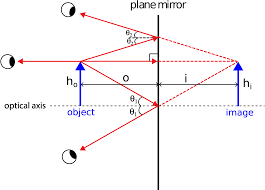When we look into a plane mirror, we see a reflection of ourselves and the objects in front of us. This reflection is formed by the light rays that bounce off the surface of the mirror and enter our eyes. Understanding how this reflection works can help us to appreciate the science behind it and its various applications. In this article, we will explore the science behind the images formed by a plane mirror and the principles that govern it. We will also look at some of the practical applications of this phenomenon.

Table of Contents
How a Plane Mirror Forms Images
A plane mirror is a flat, smooth surface that reflects light rays in a regular manner. When a light ray strikes a plane mirror, it bounces off the surface at an angle equal to the angle of incidence. The angle of incidence is the angle between the incoming light ray and the normal to the mirror surface at the point of incidence.
The reflected light ray travels in a direction that is symmetric to the incident ray with respect to the plane of the mirror. This is known as the law of reflection. The angle between the reflected ray and the normal to the mirror is also equal to the angle of incidence.
The image formed by a plane mirror is virtual, upright, and laterally inverted. Virtual means that the image cannot be projected onto a screen. Upright means that the image is not inverted, unlike the images formed by concave and convex mirrors. Laterally inverted means that the left side of the object appears on the right side of the image and vice versa.
The size of the image formed by a plane mirror is equal to the size of the object. The distance of the image from the mirror is equal to the distance of the object from the mirror. The image is located behind the mirror, at the same distance as the object.
Applications of Images Formed by Plane Mirror
The phenomenon of image formation by plane mirrors has several practical applications. Some of these are:
- Periscopes: Periscopes are devices that use two plane mirrors to allow a person to see around corners or obstacles. They are commonly used in submarines, tanks, and other military vehicles.
- Makeup mirrors: Mirrors used for applying makeup are often plane mirrors that provide a clear and true reflection of the face.
Number of Images Formed by Plane Mirrors
When two plane mirrors are placed at a 90 degree angle to each other, they form a “V” shape. To determine the number of images formed, we can use the mirror formula:
n = 360 / (angle between mirrors) – 1
In this case, the angle between the mirrors is 90 degrees, so we can plug this into the formula:
n = 360 / (90) -1 = 3
Hence, three images will be formed.
Conclusion
The formation of images by plane mirrors is a simple yet fascinating phenomenon that has many practical applications. Understanding the science behind it can help us to appreciate the role it plays in our everyday lives. Whether it is in our cars, our homes, or our workplaces, plane mirrors are an important part of modern technology that we often take for granted.
Important Links